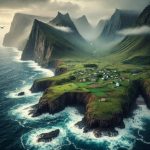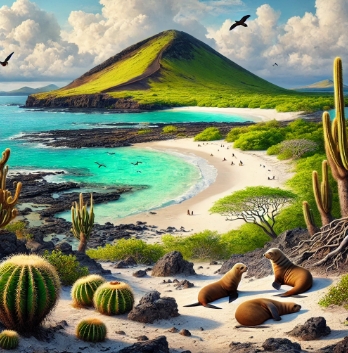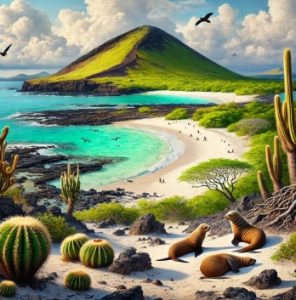Islands lost in time are rare sanctuaries where ancient traditions, untouched ecosystems, and unbroken histories continue to thrive. These remote and often mysterious places hold secrets of the past, preserved in ways that are nearly impossible to replicate elsewhere. Travelers seeking more than sandy beaches will find these islands steeped in fascinating cultural practices, pristine environments, and stories that feel like stepping into another era. From the windswept shores of Tristan da Cunha to the volcanic beauty of Socotra, these islands remind us of the richness of a world unspoiled by modernity.
Tristan da Cunha: The World’s Most Remote Island
 Located in the South Atlantic Ocean, Tristan da Cunha is often called the most isolated inhabited island on Earth. Accessible only by a seven-day boat trip from South Africa, it has a population of just 243 people as of 2024, all of whom share seven family names traced back to the island’s 19th-century settlers. According to a 2024 United Nations Environment Programme (UNEP) report, Tristan da Cunha remains a biodiversity hotspot, with over 90% of its native plant species found nowhere else. Conservationists and researchers have hailed it as one of the few places on Earth where human impact remains minimal. Source
Located in the South Atlantic Ocean, Tristan da Cunha is often called the most isolated inhabited island on Earth. Accessible only by a seven-day boat trip from South Africa, it has a population of just 243 people as of 2024, all of whom share seven family names traced back to the island’s 19th-century settlers. According to a 2024 United Nations Environment Programme (UNEP) report, Tristan da Cunha remains a biodiversity hotspot, with over 90% of its native plant species found nowhere else. Conservationists and researchers have hailed it as one of the few places on Earth where human impact remains minimal. Source
Socotra: The Alien Island

Socotra, located off the coast of Yemen, is often referred to as the “alien island” due to its otherworldly landscape. This UNESCO World Heritage Site is home to the famous Dragon’s Blood Tree, a species that has existed for millions of years. A 2024 study by the International Union for Conservation of Nature (IUCN) highlighted Soco
tra’s unparalleled biodiversity, with 37% of its plant species being endemic. Despite its isolation, Socotra has preserved its ancient traditions, including a distinct Semitic language spoken by its inhabitants. Visitors are greeted by stunning white sand beaches, towering limestone plateaus, and an ecosystem that feels untouched by time. Source
Faroe Islands: Bridging Past and Present
The Faroe Islands, nestled in the North Atlantic between Iceland and Norway, are a blend of dramatic landscapes and ancient Norse culture. Although mo

dern infrastructure has made the islands more accessible, their cultural identity remains intact. According to Visit Faroe Islands, nearly 90% of Faroese people still speak their native language, Faroese, a descendant of Old Norse. Sheep outnumber humans here, and the islands are famous for their “Grindadrap” whaling tradition, which has drawn both criticism and curiosity. The islands have also gained recognition for their commitment to sustainable tourism, with efforts to minimize overtourism while preserving their natural beauty. Source
North Sentinel Island: The Forbidden Land
Part of India’s Andaman and Nicobar archipelago, North Sentinel Island is one of the most mysterious places on Earth. Home to the Sentinelese people, an uncontacted tribe believed to have lived there for over 60,000 years, the island remains off-limits to visitors. A 2024 report by Survival International confirmed that the Indian government enforces a strict “hands-off” policy to protect the Sentinelese way of life. Their isolation has allowed them to remain untouched by modern society, making this island an anthropological treasure. However, this isolation has also raised ethical questions about preserving uncontacted tribes versus integrating them into the modern world. Source
Easter Island: A Monument to Mystery
 Easter Island, or Rapa Nui, is one of the most enigmatic islands in the world, famous for its colossal Moai statues. Located in the southeastern Pacific Ocean, it is one of the most isolated inhabited places on Earth. Archaeological research published by the National Geographic Society in 2024 revealed new insights into the construction of the Moai, including the use of ancient engineering techniques to move the massive statues. Today, Easter Island is grappling with balancing tourism and cultural preservation. Approximately 100,000 visitors arrive annually, dwarfing the island’s population of just over 7,000, creating challenges for its fragile ecosystem. Source
Easter Island, or Rapa Nui, is one of the most enigmatic islands in the world, famous for its colossal Moai statues. Located in the southeastern Pacific Ocean, it is one of the most isolated inhabited places on Earth. Archaeological research published by the National Geographic Society in 2024 revealed new insights into the construction of the Moai, including the use of ancient engineering techniques to move the massive statues. Today, Easter Island is grappling with balancing tourism and cultural preservation. Approximately 100,000 visitors arrive annually, dwarfing the island’s population of just over 7,000, creating challenges for its fragile ecosystem. Source
Floreana Island: The Galápagos Time Capsule
 Part of Ecuador’s Galápagos Islands, Floreana Island is a microcosm of untouched biodiversity and peculiar human history. It was one of the first islands in the Galápagos to be inhabited by humans in the early 20th century, and it has a history of mystery involving settlers who vanished without explanation. According to a 2024 report by the Galápagos Conservancy, Floreana Island is undergoing significant conservation efforts to reintroduce native species like the Floreana Mockingbird, which had disappeared due to invasive species. Travelers visiting this island can see firsthand how modern conservation works hand-in-hand with preserving natural and cultural history. Source
Part of Ecuador’s Galápagos Islands, Floreana Island is a microcosm of untouched biodiversity and peculiar human history. It was one of the first islands in the Galápagos to be inhabited by humans in the early 20th century, and it has a history of mystery involving settlers who vanished without explanation. According to a 2024 report by the Galápagos Conservancy, Floreana Island is undergoing significant conservation efforts to reintroduce native species like the Floreana Mockingbird, which had disappeared due to invasive species. Travelers visiting this island can see firsthand how modern conservation works hand-in-hand with preserving natural and cultural history. Source
Why These Islands Matter
Islands lost in time remind us of the fragile balance between progress and preservation. They are windows into ancient cultures, ecosystems untouched by human development, and stories of resilience against the forces of modernity. For travelers, visiting these places is not just an adventure but an opportunity to learn from worlds that operate outside the fast-paced rhythm of contemporary life. Whether it’s the biodiversity of Socotra, the cultural heritage of Easter Island, or the untouched beauty of Tristan da Cunha, these islands challenge us to think about what we value and how we protect it for future generations.
Article & Website Disclaimer
The Content within this article is for informational and educational purposes only, it is only the opinion of the creator, you should not construe any such information or other material as legal, tax, investment, financial, health and/or medical advice or other advice. Nothing contained on our Site and/or articles constitutes a solicitation, recommendation, endorsement, or offer by Umarp or any third party service provider to buy or sell any securities or other financial instruments in this or in any other jurisdiction in which such solicitation or offer would be unlawful under the securities laws of such jurisdiction. All Content on this site is information of a general nature and does not address the circumstances of any particular individual or entity. Nothing in the Site or Articles constitutes, without limitation, professional and/or financial advice, and/or medical advice nor does any information on the Site constitute a comprehensive or complete statement of the matters discussed or the law relating thereto. Any expert opinon or statistics in the articles may have inaccurate or outdated information about experts, places, or facts You alone assume the sole responsibility of evaluating the merits of all information, experts, statistical data and its risks associated with the use of any information or other Content on the Site. Before making any decisions based on such information or other Content. You should always consult a professional, advisor in the field , financial adviser and/or medical doctor before making a sound decision.








